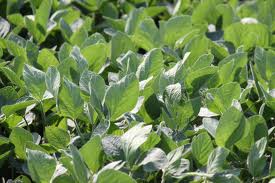Plant Nutrient Analysis: Do your soybeans have the right stuff?
August 13-2013
There has been a renewed interest in taking samples of soybean leaves for nutrient analysis as a quality control tool to ensure soil and the fertilizer programs are meeting the needs of the plant to eliminate nutrients as a yield limiting factor. Most soybean fields are at the correct growth stage to take a leaf sample for nutrient analysis as highlighted in the new video, How to take a soybean leaf sample for plant nutrient analysis.
How Do I Take A Soybean Leaf (trifoliolate or trifoliate) Sample?
- Collect leaf samples when soybeans are at the R1-R2 (Fig. 1 & 2) growth stage, but prior to R3 (Fig. 3)
 Fig. 1. R1 – Beginning Bloom: one open flower on any main stem node. Photo Credit: Nathan Mueller
Fig. 1. R1 – Beginning Bloom: one open flower on any main stem node. Photo Credit: Nathan Mueller  Fig. 2. R2 – Full Bloom: open flower present at one of the two uppermost main stem nodes with a fully developed leaf. Photo credit: Nathan Mueller
Fig. 2. R2 – Full Bloom: open flower present at one of the two uppermost main stem nodes with a fully developed leaf. Photo credit: Nathan Mueller  Fig. 3. R3 – Beginning Pod: when pods are 3/16th of an inch on one of the 4 uppermost main stem nodes with a fully developed leaf. Nutrients begin to redistribute within the plant to developing seeds in new pods, e.g., potassium moves out of leaves to the seed. Photo credit: Nathan Mueller
Fig. 3. R3 – Beginning Pod: when pods are 3/16th of an inch on one of the 4 uppermost main stem nodes with a fully developed leaf. Nutrients begin to redistribute within the plant to developing seeds in new pods, e.g., potassium moves out of leaves to the seed. Photo credit: Nathan Mueller - Identify and collect only the uppermost fully-developed leaf (trifoliolate) which is usually the third leaf from the top that is dark green, do not include the petiole (Fig. 4).
 Fig. 4. Picture of the petiole on the left and the trifoliolate (three lealfets and petiolule) on the right. Photo credit: Nathan Mueller
Fig. 4. Picture of the petiole on the left and the trifoliolate (three lealfets and petiolule) on the right. Photo credit: Nathan Mueller - Collect 30 trifoliolates without the petiole from different plants from the area of interest and put them in a brown paper bag to mail to a soil and plant analysis lab of choice.
- Interpret results based on the nutrient sufficiency ranges (Table 1).
| Nutrient | |||||
| Nitrogen (N) | |||||
| Phosphorus (P) | |||||
| Potassium (K) | |||||
| Sulfur (S) | |||||
| Calcium (Ca) | |||||
| Magnesium (Mg) | |||||
| Iron (Fe)‡ | |||||
| Manganese (Mn) | |||||
| Zinc (Zn) | |||||
| Copper (Cu) | |||||
| Boron (B) | |||||
| Chloride (Cl) | |||||
| Molybdenum (Mo) | |||||
| Aluminum (Al)‡ | |||||
| … management changes including drainage, inoculation, liming, fertilization, etc. ‡, Requires proper washing of leaves to get an accurate result. | |||||
Most soil labs also can conduct plant nutrient analysis. Per sample, the lab cost is about $34 (not including shipping) to run for all 13 plant nutrients or about $26 dollars if chloride and molybdenum are left out (the more common option available). Once you choose a lab and mail your sample, it should take a week or two to get your results back. Nitrogen (N), phosphorus (P), potassium (K), calcium (Ca), magnesium (Mg), sulfur (S), chloride (Cl) will be reported in percent (%) and copper (Cu), iron (Fe), manganese (Mn), zinc (Zn), boron (B), and molybdenum (Mo) reported in parts per million (ppm).
Additional Considerations About Plant Analysis Interpretation
If any of your nutrient values are below the sufficiency range (Table 1), your next soybean crop may or may not benefit from management changes (drainage, inoculation, fertilization, variety selection, etc.). Plant nutrient concentrations are sensitive to the environment and vary by variety. Analysis results should be used cautiously or not at all if plant samples were taken under extreme drought conditions, after flooding, or from damaged plants, i.e., herbicide carryover. However, a properly collected trifoliolate-leaf sample for monitoring soybean nutrition during the growing season is an additional tool besides regular soil testing efforts to assess soil fertility. The information is mostly useful for making future changes to your fertility program and management, not in-season. Most importantly, soil test are needed to generate fertilizer rate recommendations because plant analysis cannot tell us how much fertilizer to add.
